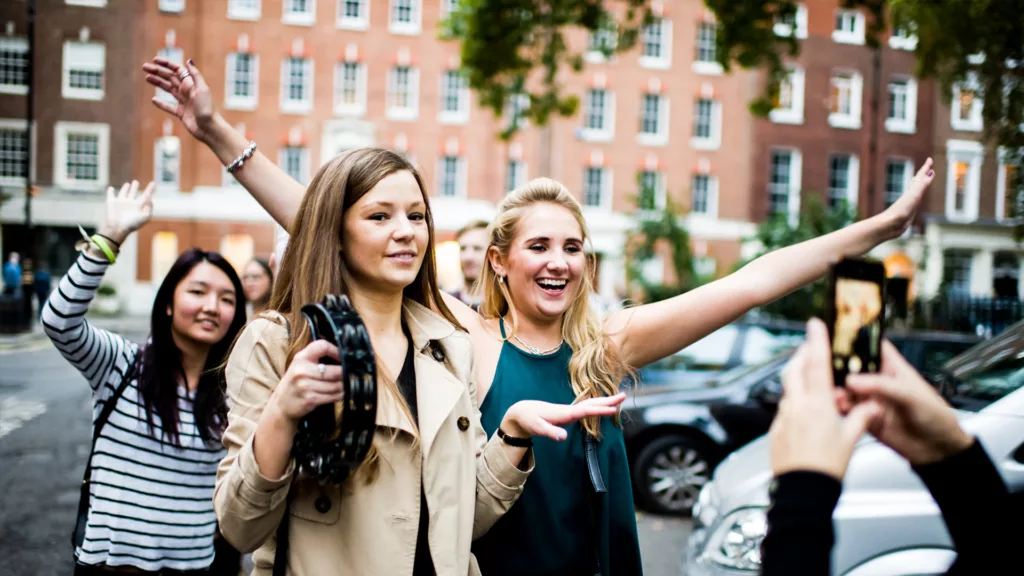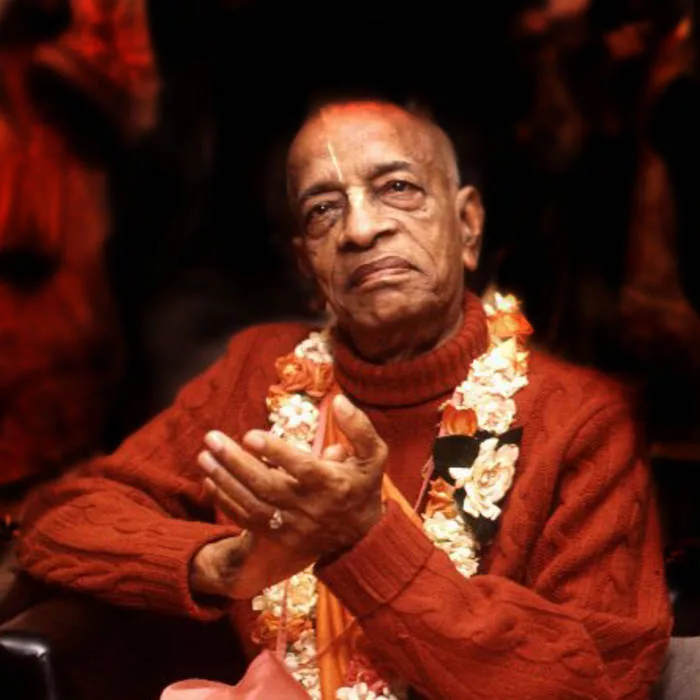When
Bhakti Landed
in London
The Master Plan
to conquer the Empire
As founder and acharya (leader) of the International Society for Krishna Consciousness(ISKCON), A.C. Bhaktivedanta Swami Prabhupada established the first Radha-Krishna Temple in New York in 1966, followed by a branch in the Haight-Ashbury district of San Francisco. In 1968, as the movement continued to expand in North America, he asked three married couples who had served at the San Francisco temple to establish a base in England. One of the devotees, Shyamsundar Das, later explained that “The scene, the centre of activity, was shifting from San Francisco to London [in 1968]”, and that the 72-year-old Prabhupada was drawn to having a base in the United Kingdom due to his upbringing as “an Indian in the British Empire”.
A former Fulbright Scholar who had worked as a professional skier, Shyamsundar was accompanied by his wife, Malati Dasi, and their baby daughter, Saraswati. Also among the six devotees was Shyamsundar’s friend from Reed College, Mukunda Das, a New York session musician and pianist with jazz saxophonist Pharoah Sanders – and Mukunda’s wife, Janaki. In October 1966, Shyamsundar and Malati had been working for the US Forest Service in Oregon at a fire lookout post when Mukunda and Janaki visited them and awakened their interest in Prabhupada’s Gaudiya Vaishnava teachings. The third couple was Gurudas and Yamuna. Before joining the Hare Krishna movement, Gurudas had spent five years in Alabama as one of Martin Luther King Jr.’s human rights supporters and then worked among San Francisco’s underprivileged communities.
Initial struggles
and innovations
After arriving in Britain, the three couples lived in separate accommodation across London and struggled financially. They met to perform their missionary activities – which included kirtans (public chanting), attending notable public events, the distribution of promotional leaflets in busy areas such as Oxford Street, and the cultivation of new members. Having previously relied on the generosity of the local Indian community, they eventually settled in a warehouse complex in Covent Garden, which also served as their temporary temple. Malati later recalled of this early period in England: “[We had] hardly any possessions, no money, no protection. It often got very cold … All we had was love for Srila Prabhupada.”
To gain wider recognition for their message, Shyamsundar had the idea of meeting the Beatles and asking them to introduce the Hare Krishna mantra, or Maha Mantra, into their songs. In October 1968, Mukunda and Shyamsundar went to the band’s Apple Records offices, on Savile Row, where Peter Asher subsequently passed a recommendation on to George Harrison, the Beatle most interested in Indian philosophy and culture. The following month, the devotees’ public appearances in Oxford Street received national attention in London’s Times newspaper. The article carried a quote from Gurudas that read: “Hare Krishna is a chant that sets God dancing on your tongue. Try chanting ‘Queen Elizabeth, Queen Elizabeth’ and see the difference.”
Meeting George Harrison
The Beatles
With Harrison busy finishing the band’s double album The Beatles and then undertaking a two-month trip to America, the meeting between him and Shyamsundar took place at Apple in December. Harrison was aware of the devotees of Krishna, having first experienced kirtana while in Vrindavan in September 1966; he had also enjoyed Prabhupada’s album ‘Krishna Consciousness’ and had begun chanting the Maha Mantra, sometimes with John Lennon. When they met in December 1968, Harrison greeted Shyamsundar with the words: “Hare Krishna. Where have you been? I’ve been waiting [years] to meet you.”
Harrison subsequently visited the devotees at their warehouse. At a time when he felt a degree of isolation within the Beatles, following his bandmates’ mixed experiences on Maharishi Mahesh Yogi’s Transcendental Meditation course in Rishikesh, India, Harrison told the devotees, “I’m inspired here.” He introduced Shyamsundar to the other Beatles in January 1969, in an effort to curb the friction that enveloped the band during their film project Let It Be, and the devotees became regular visitors to both his house in Surrey and the Apple offices.
Apple Records
The Radha-Krishna Temple
As a director of Apple, Harrison valued the record label as a means to working with acts other than the Beatles. In July 1969, he invited the devotees to Abbey Road Studios to make a recording of the Maha Mantra for release as a single. Harrison produced and performed on the song, for which Mukunda provided the musical arrangement and played mrdanga, and Yamuna and Shyamsundar served as lead vocalists. Malati, Janaki, Gurudas and others joined in as chorus singers, in addition to playing percussive instruments such as kartal.
Released by Apple Records in August, and credited to Radha-Krishna Temple (London), “Hare Krishna Mantra” peaked at number 12 on the UK’s national singles chart and was a commercial success around the world. The devotees twice performed the song on BBC-TV’s Top of the Pops. The 11 October issue of the New Musical Express announced that, in addition to supporting the rock band Humble Pie at London’s Royal Festival Hall, the Radha-Krishna Temple would be performing eleven concerts at the Holborn Conway Hall between 15 October and 22 December, for which audiences were encouraged to bring their own musical instruments and participate. The same report said that further performances were scheduled in Oxford, at the Revolution Club in London, and in Amsterdam.The Temple devotees went on to play concerts across Europe to meet public demand. Mukunda later said: “We went from street people to celebrity status. Overnight.”
Aided by the association with Harrison, the single established the ancient mantra in the cultural mainstream, while also attracting many new members to ISKCON’s centres. For the growing London branch, this achievement was accompanied by a more tolerant attitude from a previously wary public. In addition, in the Gaudiya Vaishnava faith, the international popularity of the Temple’s recording was viewed as the fulfilment of a prediction by the Hare Krishna movement’s sixteenth-century avatar, Chaitanya Mahaprabhu, who had written: “One day, the chanting of the holy names of God will be heard in every town and village of the world.”
Prabhupada's first visit
Establishing the London temple
Prabhupada was pleased with his disciples’ progress but had stated that he would only visit London once they had established a formal ISKCON temple. For this purpose, Mukunda found a seven-storey premises at 7 Bury Place, close to the British Museum in London’s Bloomsbury area, for which Harrison was co-signee on the lease and helped fund. Gurudas has spoken of the problems the devotees experienced, with complaints being made against them by their former neighbours, and objections being raised by members of the community at Bury Place, and that it was only through Harrison’s guarantee that they were able to secure the new site.
With the building in a state of disrepair, Lennon offered the Temple devotees temporary accommodation on his recently purchased estate, Tittenhurst Park, near Ascot, while renovations were underway at Bury Place. The devotees occupied the servants’ quarters at Tittenhurst Park, close to the main house, and assisted in their hosts’ renovation of the 72-acre property.
In September 1969, Prabhupada finally came to visit the new UK base, reuniting with his disciples and meeting Harrison and Lennon for the first time. Held in a former recital hall in the grounds of Tittenhurst Park, Prabhupada’s meeting with the two Beatles and Yoko Ono, Lennon’s wife, led to a famous philosophical discussion about topics such as the Bhagavad Gita, mantras and Krishna.
In December 1969, Prabhupada and the devotees – which now numbered 25, in Gurudas’ estimation – moved into the new Radha-Krishna Temple at Bury Place. The location allowed for easy access to Oxford Street, which continued to be the Krishnas’ main area of interaction with the public in central London.
Further Contributions
from George Harrison
In 1970 George Harrison produced The Radha Krishna Temple album with the devotees. In his solo recordings, many songs included devotional references, such as “My Sweet Lord” (referring to Krishna), which had the Hare Krishna maha-mantra in the chorus. In that year, George also paid for the printing of Srila Prabhupada’s book Krishna, the Supreme Personality of Godhead.
By 1972, ISKCON London, like ISKCON around the world, was growing rapidly, and the Bury Place temple was getting too small. A new building was required. George Harrison asked a British devotee, Dhananjaya Dasa, to find a large property not too far from London, and in 1973 George bought a manor house on seventeen acres in Hertfordshire. Later that year it was named Bhaktivedanta Manor.
Bhaktivedanta Manor
from George Harrison
George gifted it to ISKCON, and it eventually became the headquarters of ISKCON in the UK. Srila Prabhupada went there regularly to spend time with devotees. He said of George, “Because he has given shelter to Krishna by providing this temple, Krishna will surely provide shelter for him.” Just before Srila Prabhupada left this world in 1977, he removed a ring from his right hand and told the disciples around him, “This is for George. Give it to him.”
Soho Street
A New Home for Sri Sri Radha-Londonishvara
In 1978 Sri Sri Radha-Londonishvara, Jagannatha, Baladeva, and Subhadra Devi, and Gaura-Nitai moved from Bury Place to a six-story building in Soho Street, just off Oxford Street, where They still reside.
One of the distinctive features of the Radha-Krishna Temple in Soho Street is that, although not the largest of temples, it is right in the center of the city, next to Europe’s busiest shopping street. This provides great potential for outreach, with thousands of shoppers and passers-by daily.
Timeline
Sep 1968
3 Couples were sent to London
Lorem ipsum dolor sit amet, consectetur adipisicing elit, sed do eiusmod tempor incididunt ut labore et dolore magna aliqua. Ut enim ad minim veniam
Dec 1968
Meeting George Harrison
Lorem ipsum dolor sit amet, consectetur adipisicing elit, sed do eiusmod tempor incididunt ut labore et dolore magna aliqua. Ut enim ad minim veniam
July 1969
Recording for Apple Records
Lorem ipsum dolor sit amet, consectetur adipisicing elit, sed do eiusmod tempor incididunt ut labore et dolore magna aliqua. Ut enim ad minim veniam
Sep 1969
Prabhupada Visited The UK base
Lorem ipsum dolor sit amet, consectetur adipisicing elit, sed do eiusmod tempor incididunt ut labore et dolore magna aliqua. Ut enim ad minim veniam
Dec 1969
Radha-Krishna Temple established at Bury Place
Lorem ipsum dolor sit amet, consectetur adipisicing elit, sed do eiusmod tempor incididunt ut labore et dolore magna aliqua. Ut enim ad minim veniam
1973
George bought Bhaktivedanta Manor
Lorem ipsum dolor sit amet, consectetur adipisicing elit, sed do eiusmod tempor incididunt ut labore et dolore magna aliqua. Ut enim ad minim veniam
Today
Lorem ipsum dolor sit amet
Lorem ipsum dolor sit amet, consectetur adipisicing elit, sed do eiusmod tempor incididunt ut labore et dolore magna aliqua. Ut enim ad minim veniam


